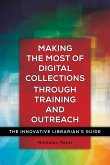- Broschiertes Buch
- Merkliste
- Auf die Merkliste
- Bewerten Bewerten
- Teilen
- Produkt teilen
- Produkterinnerung
- Produkterinnerung
This exploration of juvenile corrections librarianship provides a complete description of these specialized services, addresses unique challenges in this library environment, and promotes intellectual and social growth for at-risk youth.
Andere Kunden interessierten sich auch für
![Developing Dynamic Intersections Between Collection Development and Information Literacy Instruction Developing Dynamic Intersections Between Collection Development and Information Literacy Instruction]() Amanda ScullDeveloping Dynamic Intersections Between Collection Development and Information Literacy Instruction113,99 €
Amanda ScullDeveloping Dynamic Intersections Between Collection Development and Information Literacy Instruction113,99 €![Maximizing the Impact of Comics in Your Library Maximizing the Impact of Comics in Your Library]() Jack PhoenixMaximizing the Impact of Comics in Your Library60,99 €
Jack PhoenixMaximizing the Impact of Comics in Your Library60,99 €![Audio Recorders to Zucchini Seeds Audio Recorders to Zucchini Seeds]() Mark RobisonAudio Recorders to Zucchini Seeds66,99 €
Mark RobisonAudio Recorders to Zucchini Seeds66,99 €![Ebooked! Ebooked!]() H. Anthony BandyEbooked!50,99 €
H. Anthony BandyEbooked!50,99 €![Making the Most of Digital Collections through Training and Outreach Making the Most of Digital Collections through Training and Outreach]() Nicholas TanziMaking the Most of Digital Collections through Training and Outreach55,99 €
Nicholas TanziMaking the Most of Digital Collections through Training and Outreach55,99 €![Read On...Graphic Novels Read On...Graphic Novels]() Abby AlpertRead On...Graphic Novels46,99 €
Abby AlpertRead On...Graphic Novels46,99 €![Rainbow Family Collections Rainbow Family Collections]() Jamie Campbell NaidooRainbow Family Collections68,99 €
Jamie Campbell NaidooRainbow Family Collections68,99 €-
-
-
This exploration of juvenile corrections librarianship provides a complete description of these specialized services, addresses unique challenges in this library environment, and promotes intellectual and social growth for at-risk youth.
Produktdetails
- Produktdetails
- Verlag: Libraries Unlimited
- Seitenzahl: 156
- Erscheinungstermin: 30. Dezember 2011
- Englisch
- Abmessung: 254mm x 178mm x 9mm
- Gewicht: 308g
- ISBN-13: 9781598846744
- ISBN-10: 1598846744
- Artikelnr.: 32210797
- Herstellerkennzeichnung
- Libri GmbH
- Europaallee 1
- 36244 Bad Hersfeld
- gpsr@libri.de
- Verlag: Libraries Unlimited
- Seitenzahl: 156
- Erscheinungstermin: 30. Dezember 2011
- Englisch
- Abmessung: 254mm x 178mm x 9mm
- Gewicht: 308g
- ISBN-13: 9781598846744
- ISBN-10: 1598846744
- Artikelnr.: 32210797
- Herstellerkennzeichnung
- Libri GmbH
- Europaallee 1
- 36244 Bad Hersfeld
- gpsr@libri.de
Jennifer Sweeney
Preface
Acknowledgments
Introduction
Why This Book
What's in the Book
Notes on the Research
1. "A Perpetual Tug of War": Conflicting Paradigms in Juvenile Detention
A Brief History of Juvenile Detention in the United States
The Houses of Refuge
Industrial Schools, Training Schools, and Reformatories
Twentieth-century Juvenile Detention
Camps, Ranches, and Community-based Corrections
1970s and 1980s: From Reformation to Punishment
A Brief History of Education in Detention
Libraries in Juvenile Detention
2. The Juvenile Justice Process Today
First Contact: Law Enforcement
Juvenile Court Intake
Adjudication
Disposition
Types of Facilities
3. Information Needs of Youth in Detention
Who Are Your Users? Demographics of Youth in Detention Today
Age of Juveniles in Detention
Race and Ethnicity
Status Offenders Versus Delinquent Offenders
Custody Rate
Mental Health, Substance Abuse, and Other Issues
Information Needs of Teens
Cognitive and Behavioral Issues Associated with Juvenile Delinquency
4. Information Services for Youth in Detention
The Trend Toward Balanced and Restorative Justice
A Special Kind of Reader's Advisory
Cognitive-behavioral Therapy
Engagement: Building Relationships and Trust with Youth
Free Voluntary Reading (or, How Detention Libraries Boost Literacy)
Getting Them Started: Creating a Culture of Reading
5. Detention Library Service Models
The School Library
The Public Library
Living Unit Collections
Outreach
Other Support for Library Services: State Institutional Library Consultants
Trends in Detention Facility Design and Construction
Security Policies Affecting Access to Libraries and Library Materials
Library Service Agreements
Computing in Detention
Organizing Materials for Access
6. Model Programs and Services
Book Talks and Book Discussion
Speakers and Performers
Creative Writing Programs
Arts Programs
Reentry Programs
Reading to Children and Parenting
Practical Matters
Information Literacy Instruction: Keep It Simple
The Art of Programming
Model Programs
Changing Lives Through Literature
Read to Succeed
Write to Read
Writing for Our Lives
Second Chance Books
Free Minds
Digital Storytelling
Reading Fathers
Born to Read and Read to Me
Great Transitions Program: Struggle, Achieve, Change
A.R.T.C. (Achieving Recovery Through Creativity)
7. Strange but True: Inside the World of Detention Library Collection
Development
Censorship: What's Prohibited and Why
Striking a Balance
Understanding the Environment
The Bad Words Debate: Defending the Collection
Be Proactive: Communicate!
Building Collections for These Teens: Some Nuts and Bolts
8. From Conflict to Cooperation: Making It Work in Detention
Parallel Challenges in Social Work
Administrative Complexities
Communication Issues
Differing Expectations
Relationships with Teachers
Creating a Culture of Reading
9. Conclusion: The Future Role of Librarians Serving Teens in Detention
Appendix A: Model Policies
Appendix B: Resources
References
Index
Acknowledgments
Introduction
Why This Book
What's in the Book
Notes on the Research
1. "A Perpetual Tug of War": Conflicting Paradigms in Juvenile Detention
A Brief History of Juvenile Detention in the United States
The Houses of Refuge
Industrial Schools, Training Schools, and Reformatories
Twentieth-century Juvenile Detention
Camps, Ranches, and Community-based Corrections
1970s and 1980s: From Reformation to Punishment
A Brief History of Education in Detention
Libraries in Juvenile Detention
2. The Juvenile Justice Process Today
First Contact: Law Enforcement
Juvenile Court Intake
Adjudication
Disposition
Types of Facilities
3. Information Needs of Youth in Detention
Who Are Your Users? Demographics of Youth in Detention Today
Age of Juveniles in Detention
Race and Ethnicity
Status Offenders Versus Delinquent Offenders
Custody Rate
Mental Health, Substance Abuse, and Other Issues
Information Needs of Teens
Cognitive and Behavioral Issues Associated with Juvenile Delinquency
4. Information Services for Youth in Detention
The Trend Toward Balanced and Restorative Justice
A Special Kind of Reader's Advisory
Cognitive-behavioral Therapy
Engagement: Building Relationships and Trust with Youth
Free Voluntary Reading (or, How Detention Libraries Boost Literacy)
Getting Them Started: Creating a Culture of Reading
5. Detention Library Service Models
The School Library
The Public Library
Living Unit Collections
Outreach
Other Support for Library Services: State Institutional Library Consultants
Trends in Detention Facility Design and Construction
Security Policies Affecting Access to Libraries and Library Materials
Library Service Agreements
Computing in Detention
Organizing Materials for Access
6. Model Programs and Services
Book Talks and Book Discussion
Speakers and Performers
Creative Writing Programs
Arts Programs
Reentry Programs
Reading to Children and Parenting
Practical Matters
Information Literacy Instruction: Keep It Simple
The Art of Programming
Model Programs
Changing Lives Through Literature
Read to Succeed
Write to Read
Writing for Our Lives
Second Chance Books
Free Minds
Digital Storytelling
Reading Fathers
Born to Read and Read to Me
Great Transitions Program: Struggle, Achieve, Change
A.R.T.C. (Achieving Recovery Through Creativity)
7. Strange but True: Inside the World of Detention Library Collection
Development
Censorship: What's Prohibited and Why
Striking a Balance
Understanding the Environment
The Bad Words Debate: Defending the Collection
Be Proactive: Communicate!
Building Collections for These Teens: Some Nuts and Bolts
8. From Conflict to Cooperation: Making It Work in Detention
Parallel Challenges in Social Work
Administrative Complexities
Communication Issues
Differing Expectations
Relationships with Teachers
Creating a Culture of Reading
9. Conclusion: The Future Role of Librarians Serving Teens in Detention
Appendix A: Model Policies
Appendix B: Resources
References
Index
Preface
Acknowledgments
Introduction
Why This Book
What's in the Book
Notes on the Research
1. "A Perpetual Tug of War": Conflicting Paradigms in Juvenile Detention
A Brief History of Juvenile Detention in the United States
The Houses of Refuge
Industrial Schools, Training Schools, and Reformatories
Twentieth-century Juvenile Detention
Camps, Ranches, and Community-based Corrections
1970s and 1980s: From Reformation to Punishment
A Brief History of Education in Detention
Libraries in Juvenile Detention
2. The Juvenile Justice Process Today
First Contact: Law Enforcement
Juvenile Court Intake
Adjudication
Disposition
Types of Facilities
3. Information Needs of Youth in Detention
Who Are Your Users? Demographics of Youth in Detention Today
Age of Juveniles in Detention
Race and Ethnicity
Status Offenders Versus Delinquent Offenders
Custody Rate
Mental Health, Substance Abuse, and Other Issues
Information Needs of Teens
Cognitive and Behavioral Issues Associated with Juvenile Delinquency
4. Information Services for Youth in Detention
The Trend Toward Balanced and Restorative Justice
A Special Kind of Reader's Advisory
Cognitive-behavioral Therapy
Engagement: Building Relationships and Trust with Youth
Free Voluntary Reading (or, How Detention Libraries Boost Literacy)
Getting Them Started: Creating a Culture of Reading
5. Detention Library Service Models
The School Library
The Public Library
Living Unit Collections
Outreach
Other Support for Library Services: State Institutional Library Consultants
Trends in Detention Facility Design and Construction
Security Policies Affecting Access to Libraries and Library Materials
Library Service Agreements
Computing in Detention
Organizing Materials for Access
6. Model Programs and Services
Book Talks and Book Discussion
Speakers and Performers
Creative Writing Programs
Arts Programs
Reentry Programs
Reading to Children and Parenting
Practical Matters
Information Literacy Instruction: Keep It Simple
The Art of Programming
Model Programs
Changing Lives Through Literature
Read to Succeed
Write to Read
Writing for Our Lives
Second Chance Books
Free Minds
Digital Storytelling
Reading Fathers
Born to Read and Read to Me
Great Transitions Program: Struggle, Achieve, Change
A.R.T.C. (Achieving Recovery Through Creativity)
7. Strange but True: Inside the World of Detention Library Collection
Development
Censorship: What's Prohibited and Why
Striking a Balance
Understanding the Environment
The Bad Words Debate: Defending the Collection
Be Proactive: Communicate!
Building Collections for These Teens: Some Nuts and Bolts
8. From Conflict to Cooperation: Making It Work in Detention
Parallel Challenges in Social Work
Administrative Complexities
Communication Issues
Differing Expectations
Relationships with Teachers
Creating a Culture of Reading
9. Conclusion: The Future Role of Librarians Serving Teens in Detention
Appendix A: Model Policies
Appendix B: Resources
References
Index
Acknowledgments
Introduction
Why This Book
What's in the Book
Notes on the Research
1. "A Perpetual Tug of War": Conflicting Paradigms in Juvenile Detention
A Brief History of Juvenile Detention in the United States
The Houses of Refuge
Industrial Schools, Training Schools, and Reformatories
Twentieth-century Juvenile Detention
Camps, Ranches, and Community-based Corrections
1970s and 1980s: From Reformation to Punishment
A Brief History of Education in Detention
Libraries in Juvenile Detention
2. The Juvenile Justice Process Today
First Contact: Law Enforcement
Juvenile Court Intake
Adjudication
Disposition
Types of Facilities
3. Information Needs of Youth in Detention
Who Are Your Users? Demographics of Youth in Detention Today
Age of Juveniles in Detention
Race and Ethnicity
Status Offenders Versus Delinquent Offenders
Custody Rate
Mental Health, Substance Abuse, and Other Issues
Information Needs of Teens
Cognitive and Behavioral Issues Associated with Juvenile Delinquency
4. Information Services for Youth in Detention
The Trend Toward Balanced and Restorative Justice
A Special Kind of Reader's Advisory
Cognitive-behavioral Therapy
Engagement: Building Relationships and Trust with Youth
Free Voluntary Reading (or, How Detention Libraries Boost Literacy)
Getting Them Started: Creating a Culture of Reading
5. Detention Library Service Models
The School Library
The Public Library
Living Unit Collections
Outreach
Other Support for Library Services: State Institutional Library Consultants
Trends in Detention Facility Design and Construction
Security Policies Affecting Access to Libraries and Library Materials
Library Service Agreements
Computing in Detention
Organizing Materials for Access
6. Model Programs and Services
Book Talks and Book Discussion
Speakers and Performers
Creative Writing Programs
Arts Programs
Reentry Programs
Reading to Children and Parenting
Practical Matters
Information Literacy Instruction: Keep It Simple
The Art of Programming
Model Programs
Changing Lives Through Literature
Read to Succeed
Write to Read
Writing for Our Lives
Second Chance Books
Free Minds
Digital Storytelling
Reading Fathers
Born to Read and Read to Me
Great Transitions Program: Struggle, Achieve, Change
A.R.T.C. (Achieving Recovery Through Creativity)
7. Strange but True: Inside the World of Detention Library Collection
Development
Censorship: What's Prohibited and Why
Striking a Balance
Understanding the Environment
The Bad Words Debate: Defending the Collection
Be Proactive: Communicate!
Building Collections for These Teens: Some Nuts and Bolts
8. From Conflict to Cooperation: Making It Work in Detention
Parallel Challenges in Social Work
Administrative Complexities
Communication Issues
Differing Expectations
Relationships with Teachers
Creating a Culture of Reading
9. Conclusion: The Future Role of Librarians Serving Teens in Detention
Appendix A: Model Policies
Appendix B: Resources
References
Index








